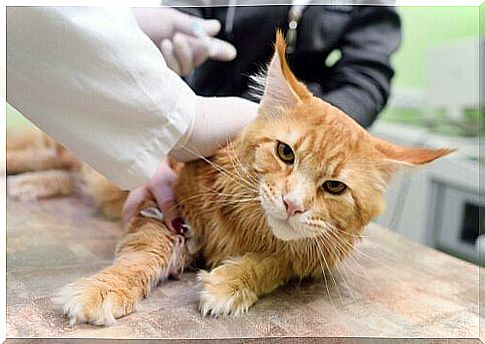Diseases Transmitted By Cats

Like dogs, cats have accompanied humans for thousands of years. Not surprisingly, they are among the most popular and loved pets in the world. Sometimes, however, their proximity can even be dangerous. There are some cat-borne diseases that can affect humans very seriously.
It is believed that only 35% of the world population has kept a cat at home. Which means the chances of contracting a disease from this animal are unlikely. Obviously we don’t want to scare you and these types of infections are very rare. But, anyway, it’s worth knowing them.
What are the diseases transmitted by cats?
Cats, despite being beloved companions in life, can be carriers of dangerous diseases that can even bring the human immune system to its knees. Most of these are transmitted through direct contact. But there are also other forms of contagion.
For example, poor hygiene care. Poor management of urine and feces can trigger a possible zoonosis . These organic residues harbor a high degree of bacteria and parasites that bring serious consequences to the human organism. Other forms of transmission of diseases infected by cats include, of course, the airways.
The latter is crucial, because this is how major pandemics, such as avian flu and even H1N1, circulate from person to person. Below, we will talk about the three main diseases transmitted by cats.
Lyme disease (borreliosis)
It is a bacterial disease that is usually transmitted by ticks with their bites. Cats can pass it on by accident if they have been infected by a sting from those arachnids. The ideal when adopting a cat is to check whether or not it has parasites on the skin and to carry out the respective tests.

Lyme disease is caused by the bacterium Borrelia burgdorferi . It should be noted that not all ticks transmit this disease. They only do this if they feed on an animal that has had this bacterium in its blood. The disease has 3 degrees of infection :
- Primary or localized : the bacterium is not yet widespread throughout the body.
- Secondary : the disease begins to spread.
- Advanced : the organism now appears compromised.
Among the symptoms of this disease, we highlight: headache, pain in joints and muscles, fever, nausea and general malaise. Once the disease develops, a very characteristic red ring of this disease appears in the bite area of the tick.
If not treated in time, the affected person runs the risk of dying. Bacteria can affect the heart and brain, causing cardiac arrest and even cognitive and speech difficulties.
Toxoplasmosis
Among the diseases transmitted by cats, toxoplasmosis is recurrent and one of the most serious. It is produced by the Toxoplasma Gondii parasite , and has a greater effect in pregnant women. It is transmitted by direct contact with the feces of cats at a young age.

For a healthy person, the disease is usually not a big deal, but for pregnant women and HIV-infected patients, it can have fatal consequences. In the first case, we are talking about spontaneous abortions while, in the second, we are talking about brain infections.
Symptoms of this disease can be confused with those of the flu. The fever, the malaise and weakness are usually the most common. The best way to avoid misdiagnosis is to visit your doctor, who will recommend the best action plan.
Anger
Another of the diseases transmitted by cats is rabies, which is produced by the Rhabdovirus . It is a common disease among pets and is transmitted through contact with infected saliva. Anger has a high degree of lethality, but fortunately there are few cases that occur globally.

Symptoms, in both cats and humans, include:
- Aggression.
- Hyperactivity.
- Temperature.
- Paralysis.
- Difficulty in breathing.
Anger has an incubation period of a couple of days before causing the sufferer’s death. To prevent this, a vaccine with a high degree of effectiveness has been developed in both humans and cats. If you have any of the symptoms described above, it is vital that you consult your doctor and veterinarian immediately to confirm the presence of the disease and establish the indicated action plan.








